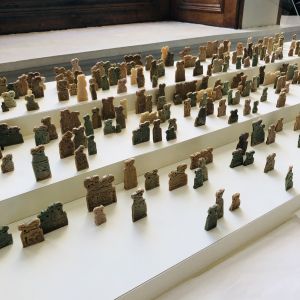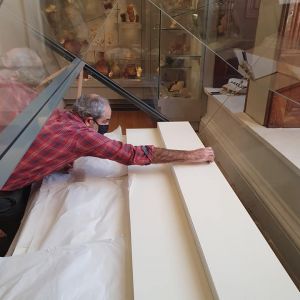Don’t Wash Your Hands: neither light agrees to enter the eyes nor air the lungs, 2020
Three Eye Idols from Tell Brak, Syria (Fitzwilliam Museum, Ancient Near East collection) & 366 eye idols made of Aleppo soap, by Syrian born artist Issam Kourbaj
This display is the Department of Antiquities’ second collaboration with contemporary artist Issam Kourbaj (the first one in 2017 titled, Dark Water, Burning World was inspired by three model ships from Syria dated 400–300 BCE). The current display brings together three unique Eye Idols originating from the Eye Temple of Tell Brak, Syria, carved out of alabaster and dated around 3200 BC, and 366 eye idols created by Issam Kourbaj and made of Aleppo soap, a material invented thousands of years ago by the Mesopotamians in the Ancient City of Aleppo.
Thousands of Eye Idol figurines (dated ca. 3700–3500 BC) made of different types of stone and more rarely produced in fired clay, have been excavated at Tell Brak in a building now called the Eye Temple. They are often interpreted as votive objects dedicated to an "eye god" venerated in the temple of Tell Brak. Many are incised with multiple sets of eyes, others with jewellery, and some others with representations of "children"—smaller eyes and body carved on the body of the larger idol. Wide eyes demonstrate attentiveness to the gods in Mesopotamian art.
Upon experiencing the ancient figurines at the Fitzwilliam Museum, Issam Kourbaj found that their simplified ‘contemporary’ form and exaggeratedly large eyes spoke volumes about both absence and presence. The work he created for the Fitzwilliam Museum’s display is a cry to the world, pleading that they do not ‘wash their hands’ of Syria and is dedicated to the Syrians who are still unable to see the light or breathe the air of freedom, yet working towards a better future.
The Fitzwilliam Museum curator said:
<iframe allow="autoplay *; encrypted-media *; fullscreen *" frameborder="0" height="175" style="width:100%;max-width:660px;overflow:hidden;background:transparent;" sandbox="allow-forms allow-popups allow-same-origin allow-scripts allow-storage-access-by-user-activation allow-top-navigation-by-user-activation" src="https://embed.podcasts.apple.com/gb/podcast/what-is-the-future-of-my-past-issam-kourbaj-in-my-minds-eye-3/id1537376207?i=1000498088501"></iframe>We are honoured to be working with Issam Kourbaj for the second time, on a project creating a dialectic between the material cultures of the ancient world and contemporary Art; as well as bridging and elucidating important social phenomena and processes traversing from Ancient Near East to our reality today. At the Fitzwilliam Museum we are halfway through a research and exhibition project examining insular versus continental cultural identities and the study of mobility and migration in its ancient and modern context. The work of Issam Kourbaj, based on concept material content, work that observes these phenomena influenced by material culture as early as the Near Eastern Early Bronze Age, adds an important dimension to our archaeological interpretations and most importantly to the way we the engage our audiences with the ancient world. As installation of the new display at the A.G. Leventis Gallery of Ancient Cyprus happened just a day before the museum’s latest closure in line with the Government’s national lockdown, we have documented the process and created a mini virtual exhibition. We invite our audiences to engage with it -until visiting the display becomes again possible- in parallel with enjoying the artist’s podcast released by the Fitzwilliam Museum on November 11, 2020.
Issam Kourbaj said:
Armed with a question about the future of my past, I have been visiting museums and collections to see artefacts from Syria in order to draw inspiration from, make artwork in response to, and raise awareness about the ongoing Syrian crisis. I first saw the Fitzwilliam Museum’s eye idols in 2017 and for months I carried the memory of them in my mind, waiting to find ways to respond to them. Three years later, in early 2020, I visited them again, and again their unforgettable and mesmerising gaze moved me; however, they also started speaking to me in a way that reminded me of a photograph of five members of my family (including myself), taken for my family's ration book in the late 1960s. But I remained unsure how to respond.
When, during the national lockdown, the museum approached me to take part in a podcast called In my mind’s eye: the museum explored, I immediately—and fittingly—thought of these eye idols. After several experiments, I decided that, whatever the shape of my response, in order to gain an insight to these eye idols, I should make it blindfolded. In this way, not only was I unable to see the original objects in the museum, I was also unable to see my response as I was making it.
Eyes are precious gifts and instruments for sight. As Orhan Pamuk described: “Before the art of illumination there was blackness and afterward there will also be blackness. Through our colours, paints, art and love, we remember that Allah had commanded us to ‘see’! To know is to remember that you've seen. To see is to know without remembering. Thus, painting is remembering the blackness” (My Name is Red, 1998, translated 2001). As an artist, however, I strongly believe that our most precious gifts are our hands—instruments for both sight and insight.
Due to the ongoing pandemic we are all reminded constantly to wash our hands. I therefore chose soap as a sculpting material, and I found myself drawn to not just any soap, but Aleppo soap, which was invented thousands of years ago by the Mesopotamians in the Ancient City of Aleppo (a UNESCO World Heritage site). Nearly a decade ago, a much longed-for and long-awaited uprising turned into war—the world’s largest humanitarian disaster since WWII. During this time, many cities turned to dust, countless Syrians were killed and forced to leave their homes, and numerous families separated and scattered in refugee camps around the world. As well as their displaced compatriots, others who stayed are threatened with starvation and more so with the current pandemic.
15th March 2021 will mark the tenth anniversary of the Syrian uprising. I have made 366 eye idols (one for every day in a leap year) and they are juxtaposed with three idols from the museum collection (one for each leap year that has passed since Syria's destruction began). Building on the thought of dedication, my installation is dedicated to the Syrians who are still unable to see the light or breathe the air of freedom. It is also a cry to the world, pleading that they do not ‘wash their hands’ of a country that once was a cradle of civilisation, and a message of hope for those who are selflessly still on the ground, working hard and training future generations to rebuild a better future for Syria.
Sign up to our emails
Be the first to hear about our news, exhibitions, events and more…



